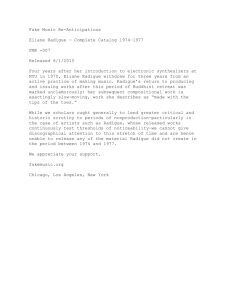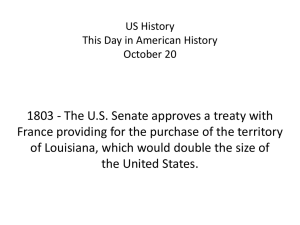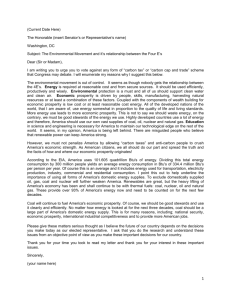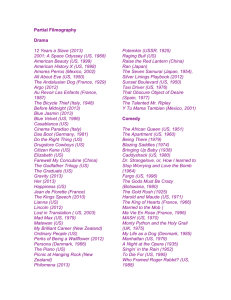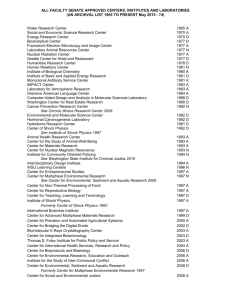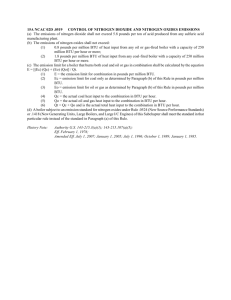A COMPARATIVE ANALYSIS OF FUEL PRICE ... Robert C. Marlay
advertisement
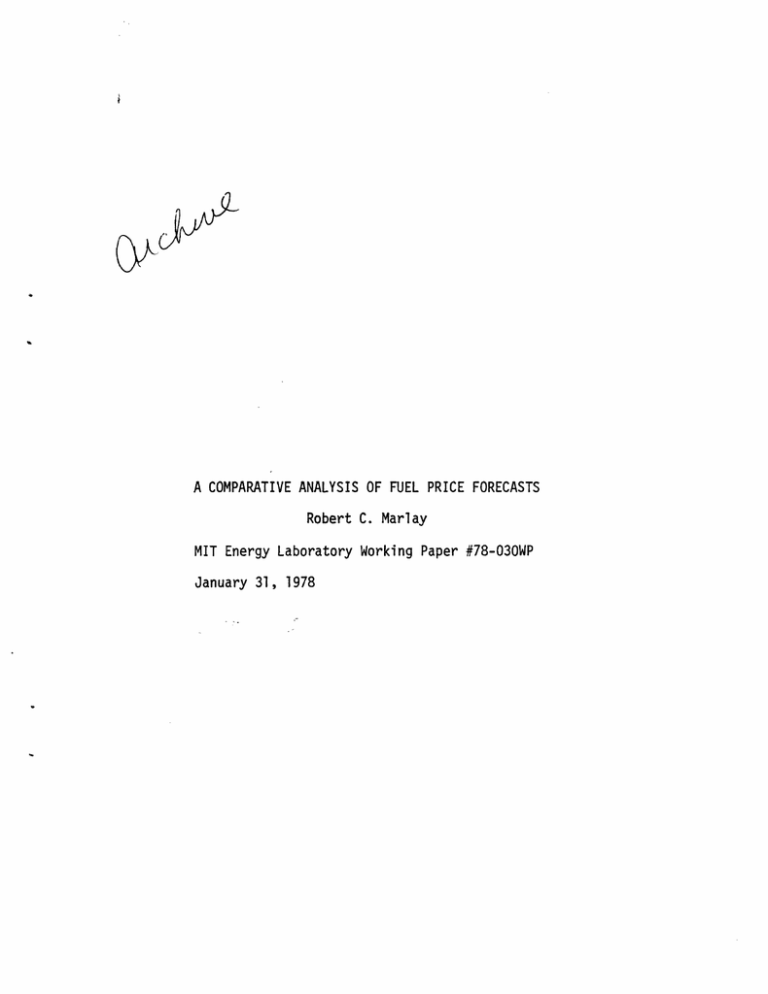
I
A COMPARATIVE ANALYSIS OF FUEL PRICE FORECASTS
Robert C. Marlay
MIT Energy Laboratory Working Paper #78-030WP
January 31, 1978
11
ABSTRACT
A comparative analysis of four sets of fuel price forecasts is
made for each of the four primary energy sources: coal, oil, natural gas
and uranium. These forecasts, together with historical data over the
period from 1960 to 1977, are presented in graphical and tabular form to
the year 2000. A graphical summary is then made of a synthesized forecast
considered most likely for each fuel, plotted in common units of 1977 cents
per million BTU, showing relative trends among competing energy forms.
TABLE
OF CONTENTS
PagR
Introduction
2
Coal
4
Oil
7
Natural Gas
8
Uranium (U3 08 )
12
Summary
17
2
The MIT Regional Electricity Model developed by Paul L. Joskow,
Associate Professor of Economics at MIT, and Martin L. Baughman,
Associate Director of Energy Modeling at the Center for Energy Studies,
University of Texas at Austin, is the principal means by which several
electric energy policy scenarios have been analyzed by the LWR study
group.*
This model, described in detail in the Joskow-Baughman article
appearing in the Spring 1976 issue of the Bell Journal of Economics, is
an engineering, econometric, and financial simulation of the U.S.
electric utility industry.
It includes submodels for energy supply and
demand and for utility financing within specific regulatory structures
and accounts for regional variations in these parameters.
The authors point out in their article that the future character of
the U.S. electric utility industry is quite sensitive not only to the
obvious leverage of the varying regulatory environment, but also to the
costs of the major competing fuels:
coal, uranium, and oil.
The model
is constrained from building any new plants which use natural gas, but
the price of natural gas does have strong effects in some regions on the
price of electricity produced by existing plants and, thereby, on total
demand in those regions.
In view of this sensitivity and the fact that some time has elapsed
since fuel price assumptions for the model were made originally, a review
of the energy price inputs has been undertaken.
Of specific interest are
*The LWR study group, organized under the auspices of the MIT Energy
Laboratory and the Department of Nuclear Engineering, was sponsored by
the U.S. Department of Energy.
3
the projections for future prices of coal, oil, natural gas, and uranium
(U30 8) over the period between 1977 and the year 2000.
In this paper
"fuel price" will be expressed in terms of an "average national price of
fuel
delivered"
to the utilities;
it will
be in 1977
constant
dollars
and
will normally appear in the form of "cents per million Btu" as a common
unit of measure.
projections:
(1)
Comparisons have been made of four sets of fuel price
the Baughman-Joskow set of price assumptions as
outlined in the 1976 article in the Bell Journal of Economics, (2) the
current price assumptions of the model as used in the December 1977 base
case simulations, (3) the August 1977 industrial energy price projections
of the U.S. Department of Energy's Office of Energy Information and
Analysis, and (4) the May 1976 price projections of the Institute for
Energy Analysis of the Oak Ridge Associated Universities as revealed in a
recently released publication entitled "Economic and Environmental
Implications of a U.S. Nuclear Moratorium, 1985-2010."
As a matter of
historical perspective, comparable data have been presented in 1977
constant dollars for the period from 1960 to 1976 from the Edison
Electric Institute (EEI) Statistical Yearbooks.
Because each set of price assumptions is expressed in different
forms, some translational errors may appear in the final analysis.
For
example, the historical data from the Edison Electric Institute are
expressed in current year dollars, per million Btu delivered to the
utility.
For natural gas in 1976 this figure is 102.4 cents.
The
figures for natural gas from the Institue for Energy Analysis are
expressed in 1975 dollars at the wellhead -- $0.43/mcf (presumably this
4
price is only for gas not previously fixed by contract).
The
Baughman-Joskow natural gas prices are for "intrastate" commerce as
expressed in future dollars, presumed to inflate at 5.5% per annum.
The
base case simulation presents its natural gas prices in terms of 1977
constant dollars (national average) per million Btu.
Lastly, the U.S.
Department of Energy (DOE) projects its natural gas prices in terms of
industrial price increases per year, for example, the price of natural
gas as paid by industrial users is projected by DOE to increase in real
terms by 8.5% per annum from 1975 to 1985, but DOE provides no estimates
for years after that.
The errors in translating these figures to a
common base, it is hoped, have been minimized by analyzing in detail the
differences in these price schemes from actual price data for the recent
years of 1974, 1975, and 1976, where overlapping occurs.
Data for the year 1977 have been constructed by taking recent data
as published in the U.S. Department of Energy's "Monthly Energy Review"
and correlating such items as "world price of oil" and "refiner's
acquisition cost per barrel," to recent years of EEI data and then making
a projection.
This analysis reveals, for example, that the mark-up from
average refiner's acquisition cost (after the government's entitlements)
to the delivered price of residual fuel oil is approximately 9%.
Coal
Figure 1 presents the comparative results for the delivered price of
coal.
As can be seen from the graph, the real price of coal had been
slowly but steadily declining from 1960 to a low in 1969.
It gradually
5
c
c
C
0
0
-
0
0
m
cN
-
00
0N
0
0U)
I
IZ
0:n
r0
I
C0
Z- o
:n
LU
o)
,
CL
(D
o
o
I'
r:
i-
0W-
z
J
I-
Zr
zl-r
WO O
L
_
0)
M
-
L
W
W
_
0
-
0)
W
Cto
U)
m
I-
-
r01
m
O a
C/C)
0)
a
m,-
n)
O~
I-
g
L
C.
U)
IS
0
0
1'
N-
0
0
LL
0
a13..
I(.
O
O
0
0
o
CD
0-
.-
0
0I--)
OD
4 -
D
O
0
I
0O
0
It
6
increased between 1970 and 1973, but was in this latter year essentially
the same price it had been in 1960 -- slightly under 60 cents per million
Btu (in 1977 constant dollars).
From 1969 to 1974 oil prices had
quadrupled in real terms and coal finally followed in this pattern by
doubling in price from 44 cents per million Btu in 1969 to 83 cents in
1974.
In real
terms,
coal prices
(as with
followed by two years of slight decline.
oil)
reached
a peak
in 1975,
The ratio of coal price to oil
price held constant at 3:4 in the sixties and is now about 1:2.
The Institute for Energy Analysis (Oak Ridge Associated
Universities) argues that coal reserves are abundant and accessible in
the U.S. and that considerable competition exists in the industry;
accordingly, it is argued, coal prices should not continue to follow oil
directly, but will be determined, instead, more by the cost of coal
production alone.
This cost, they figured in 1976, could rise at most
about 2% per year in real terms.
The study cited an identical figure as
being the most recent data from the U.S. Department of Energy.
The
Baughman-Joskow article, also in 1976, and the December 1977 base case
simulations, show coal prices to be completely independent of oil prices,
and shows them to be constant in real terms over the next 25 years at
about 100 cents per million Btu (approximatly $20/ton delivered).
In
contrast to these estimates, the more recent information from the
Office
of Energy Information and Analysis of the U.S. Department of Energy ,
shows a continuous upward price movement of 5.66% per year through 1985.
In the absence of any other data, this price curve was then arbitrarily
projected asymptotic to the 2% growth curve of the Oak Ridge group,
resulting in an AD 2000 price projection of approximately $40/ton in 1977
dollars.
7
The recent reevaluation by DOE may have been brought on by a
generally acknowledged feeling among those studying coal that doubling
coal production may not be as easy as once thought, and in recognition
that there are a great number of uncertainties about costs of coal use
and of resolving potential environmental impacts (water for coal slurry
pipelines, desulfurization).
In view of these-thoughts, special types of
coals ("conforming coals") may be required for general utility use and
the higher average price for coal in the next decade may be the more
reasonable projection.
Oil
Like coal and natural gas, oil prices declined in real terms over
the period from 1960 to 1969, bottoming out in 1969 at 55.5 cents per
million Btu ($3.46/bbl) in 1977 dollars.
In 1967, U.S. proven reserves
peaked and began a rather steep decline, which has continued at a
constant rate since that year with the one exception of the Alaskan North
Slope finds.
This rate of depletion (net) is about -3.3% per annum,
ignoring the Alaskan find.
Oil production in 1969 peaked and has been
declining since.
Concurrent with these developments, U.S. reliance upon foreign oil
imports, along with other oil-deficient industrial nations, increased to
a point where the oil cartel of exporting countries became viable.
Oil
price increased gradually in the period of transition from 55.5
cents/106 Btu (delivered to utilities) in 1969 to 105.8 cents in 1973.
8
In 1974, the OPEC cartel began to exert its full strength, quadrupling
the price of oil on the world market to more than $12/bbl.
The price of
oil delivered to the U.S. electric utilities increased accordingly, but
to a level below world price, because oil pricing regulations imposed
upon domestic production (old oil was frozen at $5.25 per barrel) lowered
the average prices.
Oil price peaked in 1975 at 223.7 cents/106 Btu
($13.66/bbl in 1977 dollars), and declined in real terms in the years
following to a current 1977 price of 210.7 cents/106 Btu ($12.95/bbl).
The average cost of an imported barrel,* as a comparison in mid-1977, was
$14.61/bbl; a domestic barrel was $9.15 (the average of "old oil," "new
oil" and "produced under exempted conditions"); and the average refiner's
acquiition cost (after entitlements) was $11.80/bbl.**
It is interesting
to note at this point that the cost of residual fuel oil to the utilities
is about 9 to 10 percent above the average refiner's acquisition cost.
This latter cost can be expected to rise eventually to the cost of an
imported barrel, given that "new domestic oil" is priced comparably with
imports and that "old domestic oil" is fast being depleted, thereby
reducing its fraction in the domestic price computation.
Therefore, in
the next decade, oil prices as paid by U.S. utilities can be expected to
rise gradually to, and ultimately follow, world price.
World price of oil, now established by dictum of OPEC, is expected
to rise more rapidly than general prices for two main reasons:
*"Landed cost" on U.S. shores.
**FEA's Monthly Energy Review, August 1977, p. 71.
(1) world
9
demand for oil will increase in response to population growth,
industrialization of less developed countries, and in general, with world
GNP growth, and (2) more costly oil resources will be developed,
effectively placing a floor under world prices equivalent to replacement
cost.
Assuming restraint on the part of OPEC, as exhibited in recent price
announcements, to limit price increases to the rate of world inflation,
the price of oil on the world market is expected to increase in real
terms to U.S. refiners by not more than 2 to 3 percent per year.
The Department of Energy projects domestic oil prices to rise about
2.55% per annum to 1985.
The Oak Ridge study group projects that
domestic oil prices will rise to world price by or prior to 1985, and
will rise thereafter by 3% per annum; world price in 1985 (assumed to
mean landed cost of world oil on U.S. shores) was assumed to be $16/bbl
in 1975 dollars ($17.86 in 1977 dollars).
The Baughman-Joskow simulation
assumed prices would increase rapidly between 1975 and 1980, but would
level off indefinitely after 1985 at about 255 cents/106 Btu
($14.79/bbl) delivered to the utilities; using the 9% rule for refiner's
mark-up, this would put landed world oil at less than $13.60/bbl.
The
current base case oil prices start in 1977 at 296 cents/106 Btu, which
is 40% above actual price data, seems to be in error.
A graphical
summary of these projections appears in Figure 2.
Natural Gas
The price of interstate U.S. natural gas, whether produced
domestically or imported as LNG, is controlled by the Federal Energy
_a
.0
0
0ro
N
N
A
~10
..
.0
N
0
I2
_
-%
0
0O
=(A
Wn
0
O
c
_1
=)
)
0n
0,
OI' ~0
_
0U
6)
O
0
-
O :
.
US
cLi
m
C
¢l
D
0)
O
O
to
10
0
0
0
0
to
0
0
0
0
-N
C
11
Regulatory Commission (FERC, the old FPC), now part of the Department of
Energy, until such time that natural gas may be deregulated.
In the
precedent setting Supreme Court ruling of 1954, this price by law must be
reflective only of the costs of production and not of market value with
Consequently, the historical pattern of natural
respect to other fuels.
gas prices has been rather constant after adjustments for inflation.
Despite its attractiveness as a premium fuel, exceptionally clean and
versatile, its price through 1975 was below that of equivalent amounts of
oil, and even coal.
Intrastate gas, however, is an uncontrolled commodity, and many
utilities which have gas-fired plants, built these plants in
gas-producing states.
Market prices in the intrastate market, and recent
pricing decisions of the FERC, have together pushed the average national
delivered price of natural gas to 130 cents/106 Btu, as compiled by EEI.
Forecasts are extremely uncertain for this fuel.
Recent intrastate
prices have risen to the order of $2.25/mcf, but may be falling off
somewhat now; new gas at the wellhead destined for interstate pipelines
is $1.48; LNG landed at east coast shores from Algeria has been running
at $1.23 to $1.30/mcf under old contracts and new contracts may be much
higher; President Carter's energy plan calls for a new price at the
wellhead of $1.75, and adds a phased-in system of "use taxes" on
utilities, tied to the price of oil as an incentive to convert to coal,
equaling 50 cents per 106 Btu; lastly a plurality of U.S. Senators has
voted for deregulation where the natural gas price could seek its own
level in the marketplace -- probably above that of oil because of its
premium fuel attributes.
12
Because of these uncertainties, DOE stopped forecasting any price as
of August 1977.
The last estimate had natural gas prices rising rapidly
and reaching the equivalent price of oil on the world market by 1985.
The Oak Ridge study group also projects natural gas prices to equal that
of world oil by 1985.
In stark contrast, both the Baughman-Joskow
simulation, and that of the December 1977 base case simulations, show
natural gas prices slightly declining through 1985, and then remaining
relatively constant through the year 2000.
This latter scenario
presumably expects abundant new discoveries in the presence of strong
financial incentives, thereby driving price down somewhat.
A summary of
these four projections appears in Figure 3.
Uranium
Like natural gas, uranium prices are extremely uncertain given wide
variations in potential supply and demand.
Common wisdom among utility
planners, however, says that U3 08 prices will rise in real terms only
by 1 or 2 percent per year from the current spot price of $42 to $44 per
pound.
A recently published report* surveying the 1976 uranium marketing
activity in the U.S. cited average delivered prices for contracts each
year out to 1985.
In current dollars, these delivery prices seem to
average about $17/lb in 1976 and $30/lb in 1985, assuming 5.5% inflation
annually over this period, the price rise in real terms equals 1.57% per
year.
Recent interviews with the Public Utility Service of New Hampshire
*Supply Evaluation Branch, Division of Uranium Resources, ERDA, 8/77 as
cited in Nuclear News, August 1977, p. 67.
13
'
mmm-
E
4e
U
E
E
0o
0
tc)
o
E
0
O
0
0
0
I
_
_i
C
Vw
a)
00,
O
- 0
w
(U)
w
0)
I
0-
C
C-
O)
0
U)
0o
H
I-
(
U)
o
-r-
CD
O
LI)
a):
0
a)
0 cn
Cl
w cn
:0
0
>-
F-
CDC
0)
U).
Iz
1
1
U.
0
LL
m
z
C)
aur
0
0) 0
w oo
)
ao
ID I'Z
Z U)
O
O
0)
w
a
)
-
4
0,,Q
0
<I0)
Z
0
cr o
zU0
O -
U
r)
emm
00
10
O
O
dq
0
0
0
00to
c
0
0
_
0')
wmm
0-
14
(a participant in the construction of Seabrook #1 and #2) revealed that
they are currently negotiating for U 30 8 at or slightly below the spot
price of $42/lb, indicating that uranium not already under contract may
be much more expensive than these "averaged" contract prices.
Given these limited glimpses of the uranium market, a future price
scheme has been constructed as follows:
(1) uranium now under contract
as of the end of 1976 (cited in the abovementioned survey) will increase
in real terms at 1.5% per annum from the 1976 price of $16.10/lb
($17.00/lb in 1977 $) due to renegotiations; (2) uranium not under
contract as of this date is assumed to also increase in real terms at
1.5% per annum, but from the 1977 spot price of $42/lb; (3) the average
national price in any one year is the weighted sum of these two portions
of total supply based upon data showing the percent of uranium
requirements (as projected by DOE) committed to the lower prices by prior
contract.
A graphical representation of this averaging scheme is
portrayed in Figure 4.
Besides the "$42 ceiling," the "$17 floor" and the weighted average
price curve, Figure 4 shows the U30 8 price assumptions made in 1976
by Baughman and Joskow (converted to 1977 constant dollars) and the price
assumption of the December 1977 base case simulations.
The base case
assumption appears very low because it reflects a
"price-versus-cumulative-production' curve based on ERDA's 1976 "forward
cost" figures.
These figures listed more than 700,000 tons of U30 8
available at $10/lb and below, and the model, over the course of 20
future years, predicted cumulative consumption to be not much more than
this.
15
.0
o
c.
m
m1
00
0N
OR
0 w
O
a-
3:
0
Y.
0
OL
zI
\
H
LO
\
(D\
0)
-J :
CY)
0)
L<
=
2
-N>Q
x
D
('
w
_0
CD
o
U)
C)
In
Go-a
in
l
c
I/
cD
z
0
0a)
I
0
I
crr
W Zz
.0
N
N
.0
o
O
:-
z
Q
W
W
O O
a.
w
>Z
>
i44
Ct
0
0L1-.)
I'.
I
_
0
O
0)
aO
w
O
Qa
I-
C
1-
Iu
O
O -
cC
C
C)
0)
w
C,
i:
0
U)
O
q;2.
to
cr
r0ow
CD
0)
I
LL
0
re
-J
0
0
0
rr)
0
Nc
0
rL
o
L
16
Hence, the price figure used is that of the forward cost, and is
unrealistic.
Because previous figures (on oil, gas and coal) have been expressed
in the comparative value of "cents per 106 Btu," an atttempt is made
below to show what the "price per pound" figures might mean if converted
to the common unit of prices measure of the other fuels.
To do this, the
following and somewhat arbitrary assumptions have been made:
a)
nuclear reactor life = 30 years
b)
1000 MWe at 30% efficiency
c)
utilization factor = 0.636
d)
initial core load = 530 short tons U3 0 8
e)
annnual makeup = 230 short tons U3 08
(burnup = 27,000
MWd/tonne)
f)
total 30-year U3 08 requirement = 7200 short tons.
Given these assumptions, the thermal output of U30 8 as a fuel is 132
x 106 Btu/lb.
At the cost ranges displayed on Figure 4, this
conversion factor yields the following:
a)
for $17/lb U3 08 -- 13 cents/10 6 Btu
b)
for $42/lb U3 0 8 -- 32 cents/10 6 Btu
Clearly, U30 8 , even at the higher price of $42/lb, is relatively
low-priced fuel when compared to the conventional forms of energy.
It is
noted, however, that costs of enrichment and fuel fabrication are not
included in these comparisons.
17
Summary
In summary, economic considerations drive the MIT Regional
Electricity Model and, by the authors' (Baughman and Joskow) own
evaluation, the model is very sensitive to fuel price inputs.
To provide
meaningful analysis, fundamental assumptions about prices must be
credible.
Current assumptions in the December 1977 base case simulation
are at significant variance from price projections made by DOE, the Oak
Ridge study group and, in some instances, actual contract prices.
From
Figures 1 through 4 one curve for each fuel has been constructed as a
suggested alternative to the December 1977 price assumptions; these four
curves are summarized in Figure 5.
Tables 1 through 8 present supporting
data and computations used to construct the curves on Figures 1 through 5.
18
_
I
_
0oo
IRAL GAS
30/mct
400
ibl
300
L NATURAL
GAS
S 2.50/mct
200
n
L
COAL
$ 30/ton
--t00
U
1965
1970
1975
1980
1985
1990
FIGURE 5 SUMMARY OF HISTORICAL (TO 1977) AND
PROJECTED ENERGY COST TO U.S. UTILITIES
1995
2000
19
SUMMARY TABLE OF PROJECTED ENERGY PRICES (CENTS/106 Btu)
(1977 CONSTANT $)
TABLE 1:
FUEL
COAL
BJ
1976
YEAR
DECEMBER 1977
BASE CASE
IEA/ORAU
1976
EEI/
DOE/MIT
-
81
1977
89
100
96
96
1980
102
103
1 02
113
1985
101
101
1 12
149
1990
105
104
1 37
189
2000
(105)
(101)
1 51
200
1975
157
1977
186
296
211
211
1980
241
318
251
227
1985
255
335
336
260
1990
261
340
389
292
1995
258
341
451
332
2000
(260)
(340)
(523)
376
NATURAL
1975
165
GAS
1977
157
163
180
130
1980
146
159
186
166
1985
130
153
336
250
1990
130
169
389
350
1995
130
169
451
400
2000
(130)
(175)
(523)
450
OIL
BJ-76:
-
96.4
1975
223.7
83.7
Baughman-Joskow Bell Journal article, Spring 1976.
December 1977 Base Case:
IEA/ORAU '76:
MIT Regional Electricity Model, run on 12/21/77.
Institute for Energy Analysis, Oak Ridge Associated
Universities, May 1976.
EEI/DOE/MIT:
Edison Electric Institute to 1976, MIT estimate for 1977
using recent DOE data, DOE projections from 77 to 85, and then MIT
estimates 85-2000.
20
TABLE 2:
YEAR
COAL
Btu/lb
_
HISTORICAL COAL PRICES TO UTILITIES 1960-1976
NATIONAL AVERAGE DELIVERED COST IN CENTS
PER 106 Btu (1977 CONSTANT DOLLARS)
AVG. COST
$/TON
__
__
AVG. COST
t/106 Btu
__
_
AVG. COST
AVG. COST
1977 $/TON 1977 /106Btu
CPI
FACTOR
_
____
__
__
__
_
77
10,870
20.81
95.7
1.0000
20.81
95.7
76
10,870
19.29
88.7
1.0551
20.35
93.6
75
10,828
18.71
86.4
1.1161
20.88
96.4
74
10,925
14.81
67.8
1.2180
18.04
82.6
73
11,130
9.32
41.9
1.3516
12.60
56.6
72
11,321
8.69
36.3
1.4358
12.48
55.1
71
11,265
8.18
36.3
1.4831
12.13
53.8
70
11,358
7.08
31.2
1.5469
10.95
48.3
69
11,726
6.26
26.7
1.6384
10.26
43.7
68
11,821
6.05
25.6
1.7265
10.45
44.2
67
11,825
5.97
25.2
1.7990
10.74
45.3
66
11,886
5.86
24.6
1.8508
10.85
45.5
65
11,942
5.83
24.4
1.9037
11.10
46.5
64
11,991
5.88
24.5
1.9365
11.39
47.4
63
12,005
6.01
25.0
1.9618
11.79
49.0
62
12,025
6.15
65.6
1.9857
12.21
50.8
61
12,024
6.22
25.9
2.0078
12.49
52.0
60
12,041
6.26
26.0
2.0282
12.70
52.7
Source: Edison Electric Institute Statistical Yearbooks. Figures for 1977
are estimates based upon data from the FEA Monthly Energy Review, adjusted to
EEI format.
21
HISTORICAL OIL PRICES TO UTILITIES 1960-1976
TABLE 3:
NATIONAL AVERAGE DELIVERED COST IN CENTS
PER 106 Btu (1977 CONSTANT DOLLARS)
RESIDUAL
FUEL OIL
YEAR
Btu/GAL
AVG. COST
$/BBL
AVG. COST
¢/106Btu
AVG. COST
CPI
FACTOR
-
1977 $/BBL
AVG. COST
-
/106Btu
1977
-
77
146,350
12 95
210,7
1.0000
12.95
210.7
76
146,350
12.34
200.7
1.0551
13.02
211.8
75
145,421
12.24
200.4
1.1161
13.66
223.7
74
145,719
11.21
183.2
1.2180
13.65
223.1
73
145,225
4.77
78.3
1.3516
6.45
105.8
72
144,933
3.78
62.1
1.4358
5.43
89.2
71
146,489
3.41
55.5
1.4831
5.06
82.3
70
146,663
2.43
39.8
1.5469
3.79
61.6
69
148,241
2.11
33.9
1.6384
3.46
55.5
68
148,692
2.13
34.1
1.7265
3.68
58.9
67
149,689
2.07
33.0
1.7990
3.72
59.4
66
150,234
2.08
32.9
1.8508
3.85
60.9
65
150,311
2.10
33.3
1.9037
4.00
63.4
64
150,723
2.08
32.9
1.9365
4.03
63.7
63
150,671
2.12
33.6
1.9618
4.16
65.7
62
150,764
2.18
34.5
1.9857
4.33
68.5
61
150,558
2.23
35.2
2.0078
4.48
70.7
60
150,514
2.17
34.3
2.0282
4.40
69.6
Source: Edison Electric Institute Statistical Yearbooks. Figures for 1977
are estimates based upon data from the FEA Monthly Energy Review, adjusted to
EEI format.
22
TABLE 4:
HISTORICAL NATURAL GAS PRICES TO UTILITIES 1960-1976
NATIONAL AVERAGE DELIVERED COST IN CENTS
PER 106 Btu (1977 CONSTANT DOLLARS)
NATURAL
GAS
YEAR
Btu/CU.FT.
AVG. COST
$/BBL
AVG. COST
¢/106
Btu
CPI
FACTOR
AVG. COST
AVG. COST
77
1023
133.0
130.0
1.0000
1977 $/BBL
133.0
76
1023
104.8
102.4
1.0551
110.6
108.0
75
1026
77.0
75.0
1.1161
85.9
83.7
74
1022
51.2
50.1
1.2180
62.4
61.0
73
1024
36.0
35.2
1.3516
48.7
47.6
72
1027
31.9
31.1
1.4358
45.8
44.7
71
1025
29.9
29.1
1.4831
44.3
43.2
70
1029
28.0
27.2
1.5469
43.3
42.1
69
1031
26.4
25.6
1.6384
43.3
41.9
68
1037
26.1
25.1
1.7265
45.7
44.3
67
1034
25.4
24.6
1.7990
45.1
43.3
66
1036
25.8
25.0
1.8508
47.8
46.3
65
1033
25.7
24.9
1.9037
48.9
47.4
64
1031
26.1
25.3
1.9365
50.5
49.0
63
1027
26.1
25.4
1.9618
51.2
49.8
62
1034
27.2
26.3
1.9857
54.0
52.2
61
1028
27.0
26.3
2.0078
54.2
52.8
60
1034
25.2
24.4
2.0282
54.2
52.8
-
1977
i/0l6Btl
130.0
Source: Edison Electric Institute Statistical Yearbooks. Figures for 1977
are estimates based upon data from FEA's Monthly Energy Review and adjusted to
EEI format.
23
TABLE 5:
PROJECTED FUEL PRICES TO UTILITIES, 1977-2000
FROM U.S. DEPT. OF ENERGY (DOE) AND MIT REGIONAL
ELECTRICITY MODEL DECEMBER 1977 BASE CASE
CENTS PER MILLION Btu (1977 CONSTANT DOLLARS)
DEC 1977
YEAR
DOE
BASE CASE
1977
78
96.7
101.1
106.8
112.9
119.3
126.0
133.2
140.7
148.7
154
160
164
168
173
177
180
183
183
189
192
194
196
198
200
99.7
101.0
102.0
102.6
103.0
103.2
103.1
102.8
101.0
101.7
102.0
103.2
104.0
104.6
104.8
104.8
104.6
104.2
103.7
102.9
102.0
102.0
102.0
102.0
79
80
81
82
83
84
85
86
87
88
89
90
91
92
93
94
95
96
97
98
99
00
NATURAL GAS
OIL
COAL
DEC 1977
DOE
210.7
216.1
221.6
227.2
233.0
239.0
245.1
251.3
257.7
264.3
271.0
277.9
285.0
292.3
299.8
307.4
315.2
323.3
331.5
340.0
348.6
357.5
366.6
376.0
BASE CASE
295.8
302.8
310.8
318.3
321.3
325.3
327.1
329.7
334.6
335.3
336.4
336.8
338.6
340.1
340.4
340.7
341.0
341.2
341.4
341.5
341.1
341
341
341
DEC 1977
DOE
130.0
141.1
153.0
166.0
180.2
195.5
212.1
230.1
249.7
270
290
310
330
350
360
370
380
390
400
410
420
430
440
450
BASE CASE
163.1
161.7
160.3
158.8
157.1
155.5
153.8
152.0
153.2
155.3
157.0
158.9
160.3
161.7
163.1
164.6
166.2
167.6
169.4
170.1
172.0
173.0
174.0
175.0
Sources: DOE: U.S. Department of Energy August 1977 fuel price
forecasts through 1985: Coal -- 5.66% per annum, oil -- 2.55% per annum,
gas -- 8.50% per annum.
BASE CASE: simulation of 12/21/77.
.0
0O
%OCc
c4
1,-
24
oO)
0
co
0
C
rO
et
r-
1-
1-
C~
ko
IC-
cn
C-
Icc
r~
C
0o
CJ
II-
F-
4O
-4
C
.I 44
(S-
L9
V
M
Izril-
7
(
9-
:*
I
I
I
I
I
I
I
I
I
I
1
0
I-
Ia
O
a)
0
0
r.
__
O
-0"'
'.O0
C)
C) O
LO
F-
F-
F-
O
C
F-
F-
o
S.LO
N-
I-
r-P
S-
U
u
a)
C.D
c4
w
E
--
I
z
F-
,-
OF-
._
a)
, ~
s
I
I
-
n
o
3C- ,
L)
Cc
F-
F-
r-
'o
r-
C
CJ
C)
I
I
I
0
a
4-
-
II
0-
C:
-
E
H
U
U'
co
F-
44
r-
"-
t0
a
.0
-_
_"n LO
n
L
Cj
o
L
ko
C
C.
Cj
cO
CJ
E
a)
-C
I-
*_
a)
a
.
HO
D
r
-
r-
F-
4o
.0
N-_
-OI.
44
oF-
1.0
CY) 0
00
O
F-
N-
'-
-
o
o
-
4-'
c
o-
r-
I-t O
0
-
5.5.=
CL
44
oo
ko
Cl.-I
o
r
I
I
I
I
,.,
I
_-
O
I
I
I
I
I
II
I
I
C)
o
C
0-
m5
a
=
U
i
I
F-
a(a)
.0
.0
LO
-
J
-
5r-
O
N-
-
a-
I-
CD 0
_
i--'.0
0
LO
LO
co
0)
.-
F-
ca
E
.r
"-
a)
rS
.) 0
44
r-
O
F-
CO
Nu
C_
0
44-
a)
SS-
-
C
0D 0
C
CJ
0
0
I
II
I
O
I
(O
I
*
C
a
(0
Q
I
I
I
C_
a)
U)
I
A
r-_
-.
3
o o
(no
=r-
.~_
0U
__
CO
c
(
0C
_-
A
O0
_n
CD
O
(a
a .)
cn
I
I
C-)
Sa)
F-
E
OU)
a)
U,
0
(,
25
TABLE 7: INSTITUTE FOR ENERGY ANALYSIS
OAK RIDGE ASSOCIATED UNIVERSITIES
CENTS PER MILLION Btu 1977 CONSTANT DOLLARS
YEAR
COAL 6
/lO0 BTU
1977
95.7
97.6
99.6
101.6
103.6
105.7
107.8
109.9
112.1
114.4
116.7
119.0
121.4
123.8
126.3
128.8
131.4
134.0
136.7
139.4
142.2
145.0
148.0
151.0
78
79
80
81
82
83
84
85
86
87
88
89
90
91
92
93
94
95
96
97
98
99
00
OIL 6
/l OBTU
210.7
223.3
236.7
250.9
265.9
281.8
298.7
316.6
335.6
345.7
356.0
366.7
377.7
389.1
400.7
412.7
425.1
437.9
451.0
464.5
478.5
492.8
507.6
522.9
NAT. GAS
t/10
BTU
130.0
146.4
164.8
185.5
208.9
235.2
264.8
298.1
335.6
345.7
356.0
366.7
377.7
389.1
400.7
412.7
425.1
437.9
451.0
464.5
478.5
492.8
507.6
522.9
Source: "Economic and Environmental Impediments of a U.S. Nuclear
Moratorium, 1985-2010," IEA/ORAU, May 1976.
COAL:
OIL:
Assumed to rise in real price at 2% per annum.
Even annual rise in real price from 1977 to 1985 of 6% per
annum to a 1985 price of 17.86 per barrel ($16/bbl in 1975
dollars), adjusted from refiners' acquisition price to residual
fuel oil by a factor of 1.09; beyond 1985, 3% per annum.
NATURAL GAS:
Even annual rise in real price to match oil by 1985.
26
Table 8: COMPUTATION SCHEDULE FOR FORECASTED
U3 08 PRICES IN DOLLARS PER POUND AND CENTS
PER MILLION BTU (1977 CONSTANT DOLLARS)
U3 O
U3 0 *
Required
Con4_ van
Year
3
_ A
(103n
Is)
Fraction
Fraction
Average
Contracted
Not Contracted
Contract- New Coned Price 4L.- I ,.-.-L. L
($/16)
($/1 b)
(10 Tons) ( 103Tons )
(%)
(%)
Average
-
-
12
12
13
100
100
100
20
12.00
17.00
18.40
20.00
22.10
62
54
23
30
38
46
Cents
Price
Per
I
nA DTII
IUV DUIu
Equivalent
($/lb)
-
l
--
9
13
41.60
42.30
43.00
12.00
17.00
18.40
20.00
25.20
23.60
25.20
26.80
26.30
25,20
43.60
44.20
44.90
45.50
46.30
28.20
30.90
33.70
33.10
27.90
21
18
47.00
47.70
48.30
49.10
49.90
40.50
43.00
45.30
46.60
47.70
31
82
82
29.50
31.40
33.40
35.40
37.70
16
84
40.10
50.60
51.30
52.00
52.90
53.70
48.90
49.90
50.90
51.90
52.90
37
1995
1996
1997
1998
1999
54.50
55.40
56.40
57.60
58.80
54.00
55.20
56.40
57.60
58.80
41
2000
60.00
60.00
46
1975
1976
1977
1978
1979
0
0
0
0
15
Average
26
22
100
85
1980
31
24
77
1981
33
37
35
42
23
23
19
17
70
40
60
1985
1986
1987
1988
1989
41
15
12
37
29
63
42
45
9
80
44
45
8
8
20
18
1990
45
7
1982
1983
1984
1991
1992
1993
1994
71
_l
i_
_t
-
14
15
19
23
26
27
29
33
34
35
36
38
39
39
40
42
43
44
45
U 3 08 requirements and amounts under contract were obtained from Nuclear News,
August
1977, p. 67 in a summary of a report from Supply Evaluation Branch, Division
of Uranium Resources, ERDA, August 1977.

